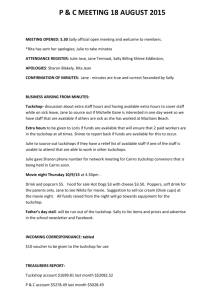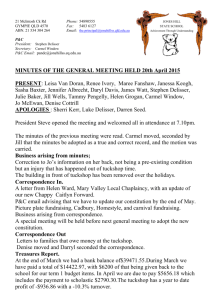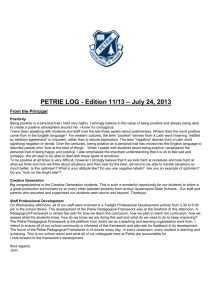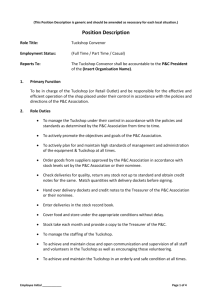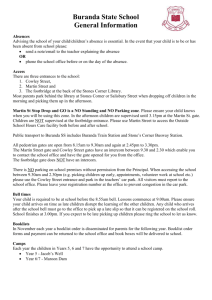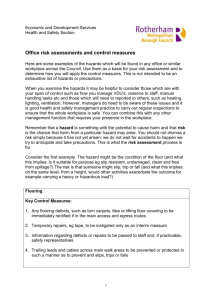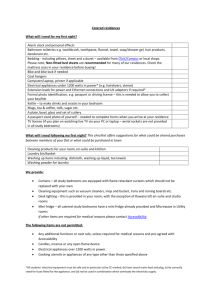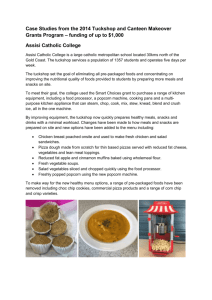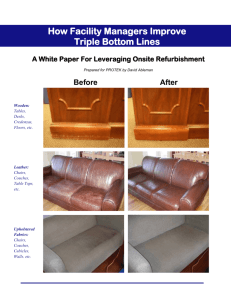Points to consider when refurbishing a school tuckshop
advertisement
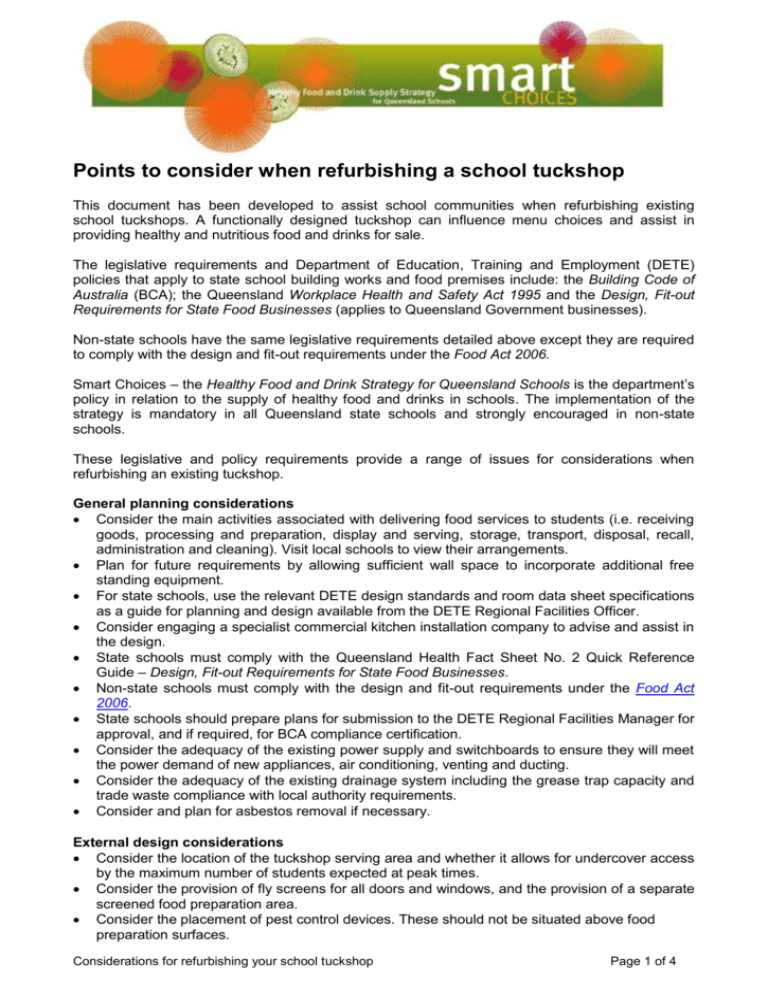
Points to consider when refurbishing a school tuckshop This document has been developed to assist school communities when refurbishing existing school tuckshops. A functionally designed tuckshop can influence menu choices and assist in providing healthy and nutritious food and drinks for sale. The legislative requirements and Department of Education, Training and Employment (DETE) policies that apply to state school building works and food premises include: the Building Code of Australia (BCA); the Queensland Workplace Health and Safety Act 1995 and the Design, Fit-out Requirements for State Food Businesses (applies to Queensland Government businesses). Non-state schools have the same legislative requirements detailed above except they are required to comply with the design and fit-out requirements under the Food Act 2006. Smart Choices – the Healthy Food and Drink Strategy for Queensland Schools is the department’s policy in relation to the supply of healthy food and drinks in schools. The implementation of the strategy is mandatory in all Queensland state schools and strongly encouraged in non-state schools. These legislative and policy requirements provide a range of issues for considerations when refurbishing an existing tuckshop. General planning considerations Consider the main activities associated with delivering food services to students (i.e. receiving goods, processing and preparation, display and serving, storage, transport, disposal, recall, administration and cleaning). Visit local schools to view their arrangements. Plan for future requirements by allowing sufficient wall space to incorporate additional free standing equipment. For state schools, use the relevant DETE design standards and room data sheet specifications as a guide for planning and design available from the DETE Regional Facilities Officer. Consider engaging a specialist commercial kitchen installation company to advise and assist in the design. State schools must comply with the Queensland Health Fact Sheet No. 2 Quick Reference Guide – Design, Fit-out Requirements for State Food Businesses. Non-state schools must comply with the design and fit-out requirements under the Food Act 2006. State schools should prepare plans for submission to the DETE Regional Facilities Manager for approval, and if required, for BCA compliance certification. Consider the adequacy of the existing power supply and switchboards to ensure they will meet the power demand of new appliances, air conditioning, venting and ducting. Consider the adequacy of the existing drainage system including the grease trap capacity and trade waste compliance with local authority requirements. Consider and plan for asbestos removal if necessary. External design considerations Consider the location of the tuckshop serving area and whether it allows for undercover access by the maximum number of students expected at peak times. Consider the provision of fly screens for all doors and windows, and the provision of a separate screened food preparation area. Consider the placement of pest control devices. These should not be situated above food preparation surfaces. Considerations for refurbishing your school tuckshop Page 1 of 4 Ensure any new water and sewerage connections meet local authority requirements. Consider out-of-hours access for supplier deliveries. Consider whether security is required, both physical and electronic. Ensure that staff has access to a documented and easily understood evacuation plan in the case of an emergency situation. Internal design considerations Consider the amount of space required to prepare food and whether there is enough space for the number of paid and volunteer staff required by the tuckshop. Cramped conditions do not create a pleasant working environment. A minimum clearance of 1200mm between fixed benches is recommended. Consider the location of doors and window openings to allow for safe and efficient equipment placement and easy access to storage areas for staff and trolleys. Consider how the premises can be effectively sealed to prevent entry by insects and vermin. Consider how the layout can restrict student access into the food preparation / kitchen area. Consider how to provide adequate artificial lighting, and where possible, how it can be supplemented by natural lighting. Consider how the premises can have sufficient natural or mechanical ventilation to effectively remove fumes, smoke, steam and vapours as well as disperse heat from cooking appliances. Consider the provision of air conditioning. Whilst not mandatory, it assists with food safety, the comfort of staff and volunteers and the efficient operation of appliances. Consider the build up of heat from refrigeration motors and the need for passive and active ventilation of these areas. Considerations regarding collection and storage of garbage and recyclable matter Consider incorporating into the facility a secure compound or holding area where garbage and recyclable materials can be stored safely and securely until collection by a contractor or it is incorporated into the school’s refuse and recycling systems. Provide lids on waste receptacles so that pests and animals can’t gain access. Pedal bins are recommended. Considerations regarding appliances Consider installing commercial quality appliances as domestic units are not designed for use in commercial kitchens. When selecting an oven consider the expected volume of food to be produced; the variety and quality of fresh food to be provided; and the speed at which food is to be prepared onsite. Commercial ovens will assist schools to meet the food safety requirements for heating products quickly. Some ovens can be bench mounted and others sit on frames. Consider a commercial quality dishwasher as this will reduce the time spent cleaning dishes by staff and volunteers (domestic units may take too long), and they provide water saving and food safety benefits. Consider installing at least a four-burner or element cook top or hot plate with sufficient space for large pans or pots used in the preparation of stir-fries and curries. Large schools may require more burners to cater for increased student numbers. If toasting of a high volume of sandwiches will be required, consider including a large commercial sandwich press. Consider the use of grillers for making pizzas and large quantities of toast. Some schools may also wish to consider purchasing appliances such as popcorn makers, blenders, mixers, pressure cookers, rice cookers and electric frypans. These appliances will require additional power sources, bench space and storage space. Consider whether food warmers are required at point of sale (POS) to keep hot meals warm and to display items for sale. Some schools may also consider including space for a bain-marie which will provide visual ideas for students when choosing items as well as keeping food hot. Consider installing glass-fronted refrigerators and warming cabinets to allow students to see items for sale. Schools that operate a self-serve tuckshop have found door-less refrigeration cabinets allow easy access by students which improves the popularity and sale of menu items. Carefully consider the placement of POS items with respect to where students queue or enter and exit to ensure maximum exposure of healthy fresh food items for sale. Considerations for refurbishing your school tuckshop Page 2 of 4 Washing-up sink Consider providing a deep double-bowl pot sink with a flexible hose and trigger rinse nozzle for cleaning commercial sized pots and pans. Food preparation sink Consider including a separate single-bowl sink for washing, peeling and rinsing vegetables and fruit. Hand washing facilities Provide a clearly designated facility for the purpose of washing hands, arms and faces, and for serving staff to use particularly if handling different commodities. Personal washing facilities should be located in the food preparation area and be easily accessible. They should be separate from and in addition to hand washing facilities provided within toilets. The hand wash basin should be of a size that allows for easy and effective hand washing. It should be fitted with potable hot and cold water and controlled by a hands-free mixer tap (either foot or knee operated). Include a wall-mounted soap dispenser over the basin. A single-use dispenser for hand-drying towels or another effective hand-drying appliance should be provided close by. Provide a used towel receptacle. Floors Floors should be able to be cleaned effectively and have a non-slip surface when wet (R10 recommended). The surface should not be so rough however that cleaning becomes difficult. The floor surface should not absorb food particles, grease or water, and should have an even slope to a floor-waste drain to prevent water pooling. Floor edges should be sealed to prevent entry of dirt, dust and pests. Walls and ceiling The walls and ceiling should protect food from contamination and prevent entry of dirt, dust and pests. The walls and ceilings should be durable and impact-resistant and should be able to be easily and effectively cleaned. The surface of the walls and ceilings should be impervious to food particles, grease or water. Food preparation surfaces Ensure all food preparation surfaces are able to be effectively cleaned and sanitised and are impervious to food particles, grease or water. The material used in the construction of food preparation surfaces should not contaminate food. Food preparation and storage areas Consider providing a small fridge near the food preparation area for storage of small quantities of commonly used ingredients. Consider providing mobile island workbenches with lockable castors to increase the flexibility of workspaces for food preparation and to allow for quick removal of food and equipment. Consider including a refrigerated salad bar. As well as meeting food safety standards, a salad bar will improve the presentation and longevity of salad items and therefore increase salad item sales. The salad bar could be incorporated in a mobile island workbench; however an overhead power outlet would be required. Consider whether you will require an additional refrigerator to allow for the storage of additional fresh food and drinks and for defrosting frozen food. Considerations for refurbishing your school tuckshop Page 3 of 4 Point of sale Consider the location of food warmers and hot food display cabinets. Consider the location of refrigerated display cabinets, frozen food cabinets and glass fronted drink fridges (back loading fridges are useful for reloading stock during peak times). For easy access and low maintenance consider refrigerated display cabinets with air curtains rather than cabinets fitted with doors. Consider providing space for a counter-top display fridge at POS for display of food items. There are several options available. The most common are cafeteria, counter, and bag service models. Each school needs to determine which is most appropriate after considering their available space, size of school, staffing, age of students and other factors. Ensure the stature of clients, particularly in primary schools, is taken into consideration when determining the height of the display/refrigeration cabinets. Consider installing self-serving or cafeteria style arrangements which may be faster than overthe-counter service options. Sufficient space is required for these styles of service to work efficiently, so viewing other schools using this style of service is recommended. Provide for both counter service and paper bag ordering if appropriate. Consider whether EFTPOS facilities should be made available. Consider providing cash registers to increase accountability and provide more accurate reporting of sales trends. Ensure secure and hygienic connection between POS and preparation areas. If air conditioning is being considered for the preparation areas, then the POS area may also benefit from this installation. This would be subject to design considerations and the fitting of air curtains or suitable door openings to seal the area from ambient temperatures. Storage Consider providing adequate bulk freezer space to increase the school’s capacity to buy food in bulk. Consider including a dry-goods storeroom or cupboard with adequate shelving to allow staff to readily view and access stored food, food containers, single use items such as packaging and other equipment. Provide separate storage areas for chemicals, away from food storage spaces. Fire safety equipment A wall mounted fire extinguisher and fire blanket should be provided. These will enhance the safety of staff by enabling a quick response to a cooking fire. Provide a wall mounted map showing the location of an emergency evacuation point, escape route and assembly area. Administration and other facilities Consider including a separate space for an office or administration area which may include a desk, computers, a printer, telephones, adequate shelving and data points for internet access and EFTPOS facilities. For food hygiene and workplace health and safety considerations, it is recommended the uniform shop be separate from the tuckshop to limit traffic through food preparation areas. Considerations for refurbishing your school tuckshop Page 4 of 4

